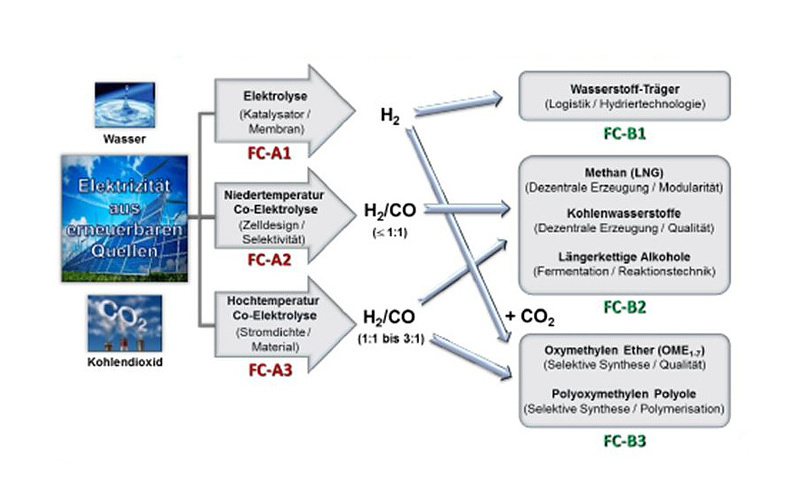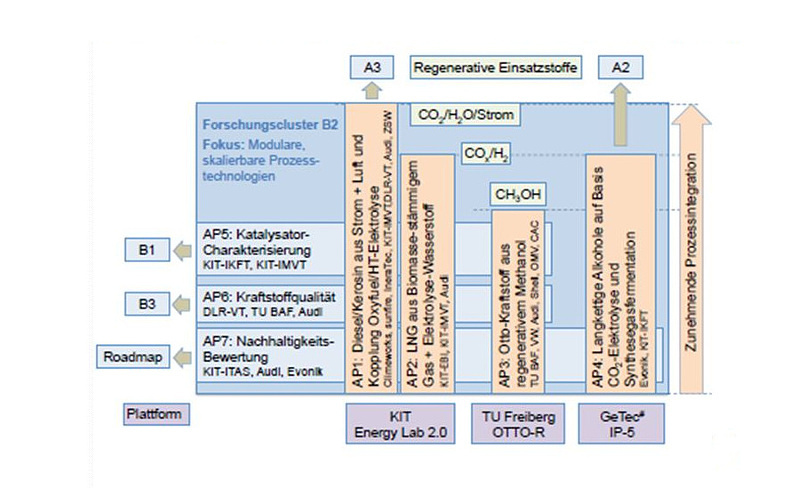Kopernikus: P2X
- Project team:
Patyk, Andreas (Project leader); Jana Späthe, Witold-Roger Poganietz, Armin Grunwald, Dominik Poncette
- Funding:
Federal Ministry of Education and Research (BMBF)
- Start date:
2016
- End date:
2019
- Project partners:
Research institutions:
RWTH Aachen University, Forschungszentrum Jülich (FZJ), TUM/LMU Munich, FAU Erlangen/Nürnberg, Karlsruhe Institute of Technology (KIT), Dechema-Forschungsinstitut (DFI), German Aerospace Center (DLR), Fraunhofer IWM/ISE, Leibniz Institute for Catalysis (LiKAT), Helmholtz-Zentrum Berlin (HZB), TU Bergakademie Freiberg, Forum SozioÖkonomie, Dechema e.V., BUND, ifeu - Institut für Energie- und Umweltforschung, Öko-Institut e. V., Wuppertal Institute, WWF, Leibniz-Forschungsverbund Energiewende (WZB/DIW)
Industrial partners:
Areva H2Gen GmbH, Arge-Netz GmbH & Co. KG, Audi AG, BASF SE, Chemieanlagenbau Chemnitz GmbH, Clariant AG, Climeworks AG, Covestro AG, ERC Additiv GmbH, Evonik Creavis GmbH, Ford-Werke GmbH, GeTec, Greenerity GmbH, Heraeus GmbH, H2Mobility Deutschland GmbH, Hydrogenious Technologies GmbH, IneraTec - Innovative Reactor Technology, Linde AG, OMV AG, RWE AG, Siemens AG, Sunfire GmbH, Shell Global Solutions GmbH, thyssenkrupp Industrial Solutions AG, Volkswagen AG, Wacker Chemie AG
- Research group:
Project description
General description of the Kopernikus initiative
The so-called Kopernikus initiative launched by the Federal Ministry of Education and Research (BMBF) is so far the largest research initiative in the field of energy transition (“Energiewende”) in Germany. The initiative is named after Nicolaus Copernicus, mathematician and astronomer, who discovered the heliocentric model of the universe in the 16th century and whose name became a byword for the age of science. The main objective of the Kopernikus funding is to stimulate comprehensive and integrative research on the energy transition in order to make the current system in a safe, affordable, and clean way fit for the future. The consideration of social, environmental, and economic aspects is essential for the transformation of the energy system. To meet these requirements, the Kopernikus projects combine technology-oriented research with systemic and transdisciplinary approaches. Thus, the projects focus on research areas showing both a high degree of complexity and a high potential for the successful transformation of the energy system. The Kopernikus projects ENSURE, P2X, SynErgie, and ENavi which have already started research key areas of the energy system in close cooperation of science, industry, and civil society.
- The ENSURE project addresses new grid structures to transport and supply high shares of renewable energy in a reliable and flexible way.
- The P2X project focuses on options to store energy in gaseous, substantial, or liquid form.
- The SynErgie project researches technologies for adapting industrial processes to the new energy supply system.
- The ENavi project analyses the interaction of the energy system sectors power, heat, and mobility as a complex, interlinked, and dynamic system.
Hence, the four Kopernikus projects cover key areas and challenges for transforming the (German) energy system. ITAS is involved in all four projects and contributes its expertise in technology assessment and systems analysis in different ways.
General description of P2X
The medium-term goal of the further development of fluctuating renewable power generation, which is intrinsically tied to the German energy transition, requires the use and storage of electricity during peak production. Apart from technologies which are in general mature, but still too expensive for mass application like different battery concepts and load change in established industrial applications, the electrolysis of water to produce hydrogen and the co-electrolysis of water and CO2 to produce syngas are promising alternatives. Here hydrogen can be stored for a later reconversion in vehicles or at a determined place or it can be fed into chemical processes; the syngas will be converted into, e.g., fuels. The conversion of hydrogen and CO2 can not only increase the utilization rate of renewable energy production. Other aspects will probably be even more important in the long-term and beyond the established needs, given the appropriate systematic expansion of renewable energy production: The greenhouse effect and the use of finite resources are reduced by substituting existing processes based on fossil input material by processes using renewable resources. Reduced to concepts whose process chains start with electrolysis and include further chemical reactions, P2X, i.e. power to X, has to be understood as chemical bound of electrical energy in hydrogen and the transformation to fuels as well as base and fine chemicals.
Of course some individual process steps of the discussed P2X concepts are mature and commercially used. However, the majority of those technologies require a considerable amount of further R&D work. The whole Kopernikus project P2X is divided into six research clusters and an overarching roadmapping process. The clusters focus on power conversion (A cluster) and the use and storage of hydrogen (B cluster) (Figure 1).
The roadmapping process includes the collection and assessment of technological, economic, ecological, and societal information and data using quantitative and qualitative methods.
Apart from its participation in the whole roadmapping process, ITAS is mainly involved in cluster B2 “Modular and self-sufficient technologies for the transformation of syngas based on CO2 to hydrocarbons and long-chain alcohols”. The cluster pursues the development of four different technologies for four different fuels or chemicals (Figure 2).
The overall aim is a scalability which also allows the economic realization of portable small systems. These technologies are
- Fischer-Tropsch synthesis combined with high-temperature electrolysis,
- methanation with coupled liquefaction,
- gasoline from renewable methanol,
- syngas fermentation to long-chain alcohols.
ITAS within the P2X project
The intended development of new process technologies should contribute to a (more) sustainable energy system. For a successful contribution to the different processes for energy system transformation investigated in the cluster, it is necessary to analyze and assess the technological-scientific, environmental, economic, and societal aspects at an early stage in a comprehensive approach and suggest optimized alternatives. The respective analyses are carried out by ITAS in the framework of research cluster B2.
Life Cycle Sustainability Assessment (LCSA) forms the methodological basis for the analysis of the selected process technologies. The LCSA assesses the sustainability of technologies during the whole life cycle regarding their environmental impacts, competitiveness, and societal implications. Typical instruments used are Life Cycle Assessment (LCA; environmental impacts), Life Cycle Costing (LCC; costs), and social LCA (sLCA; technology effects on society). However, the development status and the degree of acceptance of these three instruments are very different. LCA and LCC are more or less mature. LCA is subject to DIN EN ISO norms which are an important orientation for almost all LCAs; the exact formal standard conformance is especially recommendable for LCAs with direct competitive effects. The LCC is developed in a comparable way, but less often used. Regarding the forms of damage and objects of protection that have to be included and their respective indicators, the sLCA is still subject to intensive discussions. The main emphasis of P2X is therefore on LCA and LCC which can in turn be combined into eco-efficiency factors. Apart from ITAS which assesses three technology approaches, Audi is participating with the analysis of one approach.
ITAS is not only involved in detailed technology analyses but has also a major share in the roadmapping process of the overall project. The aim of the roadmapping process is the development and application of a joint framework for the Kopernikus project for the comparative assessment of the technologies that have to be developed in P2X regarding their technological, economic, ecological, and societal impacts. Since these technologies shall be applied in future energy systems, the roadmapping process also includes the coordination of possible energy scenarios.
Publications
Poncette, D.; Patyk, A.; Scherrieb, M.
2018. 9th International Freiberg Conference on IGCC & XtL (2018), Berlin, Germany, June 3–8, 2018
Contact
Karlsruhe Institute of Technology (KIT)
Institute for Technology Assessment and Systems Analysis (ITAS)
P.O. Box 3640
76021 Karlsruhe
Germany
Tel.: +49 721 608-24606
E-mail



